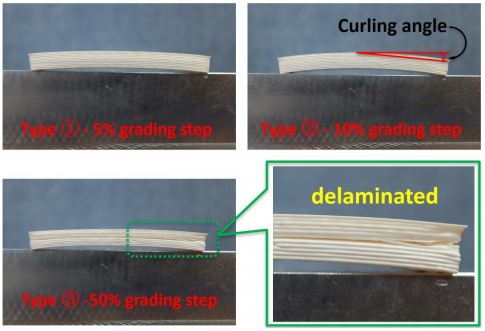A New 3D Printing Process CODE: 3D Printed Ceramics with Functionally Graded Materials
Several different methods have been developed for the 3D printing of ceramic materials, and one of those is CODE, or Ceramic On-Demand Extrusion, a recently developed extrusion-based process for the fabrication of dense, functional ceramic components. In a paper entitled “Fabricating Functionally Graded Materials by Ceramic On-Demand Extrusion with Dynamic Mixing,” a group of researchers discusses using the CODE process to create functionally graded materials, or FGM.
Functionally graded materials are defined by the researchers as “characterized by gradual variations of material compositions over volumes, which allows for a combination of materials or material properties not typically achievable in monolithic materials.” There has been a lot of interest in alumina-zirconia (Al2O3/ZrO2) components for applications such as prosthetic ball joints. In these components, the tough zirconia core provides high strength and reduces the risk of cracking, then transitions to an alumina surface, which provides long life within a human body.
“Additive manufacturing (AM) processes are especially advantageous for fabricating FGM components due to the layer-by-layer nature of the processes,” the researchers state. “Considering that the melting temperatures of ceramics are usually too high for thermal-based melt deposition and the fact that the ink jetting-based ceramic AM processes are subject to high porosity, material extrusion-based AM processes are the most favorable method for fabricating ceramic FGM components.”
In the study, the researchers developed a dynamic mixing device for the CODE system for the fabrication of FGM components. Two materials – alumina and zirconia – were extruded through separate extruders into the mixing chamber of the dynamic mixer with controlled flowrates. The mixer then blended those pastes into a homogeneous mixture, which was deposited through nozzles to create FGM components with planned material compositional distribution. The components were then post-processed and characterized to assess the functionality and accuracy of the dynamic mixing device.
Some deformation occurred in the sintered components, to the point of cracking and delamination. Deformation was also observed after the bulk drying of components, and the researchers chalk this up to the mismatch in drying shrinkage of the two pastes. The deformation during the sintering process, however, was attributed to the mismatch of sintering shrinkage and thermal expansion of the two materials.
“Larger differences in material composition between layers lead to larger stresses caused by the mismatch of material properties, which explains the fact that the larger step of changing composition led to larger amounts of deformation,” the researchers state. “A smoother (reduced) gradient of material composition is likely to reduce the amount of deformation and the risk of part failure. Adjusting the inherent properties of the raw materials to reduce the mismatch of shrinkage could be another effective way of mitigating the stress and deformation.”
Vickers hardness was also measured and was shown to decrease as the volume percentage of zirconia increased.
Overall, the study shows a promising method of 3D printing ceramic functionally graded materials. Although the printed components were not perfect, further steps can be taken in the future to reduce deformation and failure.
Authors of the paper include Wenbin Li, Austin J. Martin, Benjamin Kroehler, Alexander Henderson, Tieshu Huang, Jeremy Watts, Gregory E. Hilmas and Ming C. Leu.
Discuss this and other 3D printing topics at 3DPrintBoard.com or share your thoughts below.
Subscribe to Our Email Newsletter
Stay up-to-date on all the latest news from the 3D printing industry and receive information and offers from third party vendors.
Print Services
You May Also Like
3D Printing Financials: Prodways Ends 2024 with a Profit
After a tough couple of years, Prodways (EPA: PWG) is starting to bounce back. The French 3D printing company finally made a profit in 2024, improved its operating performance, and...
Blue Origin & Auburn University Use EOS M290 to Study Copper 3D Printing
Blue Origin, the commercial space company built off of investments from Amazon founder Jeff Bezos, has donated two EOS M290 powder bed fusion (PBF) printers to Auburn University’s National Center...
Rocket Lab to Acquire Restructured Laser Communications Provider Mynaric AG
Rocket Lab USA, the Long Beach-based, end-to-end space services company that specializes in producing rockets with additive manufacturing (AM), has announced plans to acquire Mynaric AG, a German provider laser...
3D Printing Financials: Stratasys Ends 2024 with Cost Cuts and Growth Plans
Stratasys (Nasdaq: SSYS) has wrapped up 2024 with stronger margins but a full-year net loss. The polymer 3D printing leader navigated a year of economic headwinds, restructuring efforts, and shifting...






























